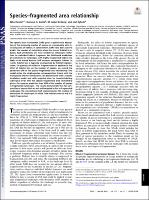| dc.creator | Hanski, Ilkka | |
| dc.creator | Zurita, Gustavo Andrés | |
| dc.creator | Bellocq, Maria Isabel | |
| dc.creator | Rybicki, Joel | |
| dc.date.accessioned | 2023-08-23T02:07:28Z | |
| dc.date.available | 2023-08-23T02:07:28Z | |
| dc.date.issued | 2013-07-30 | |
| dc.identifier.citation | Hanski, I., Zurita, G. A., Bellocq, M. I., Rybicki, J. (2013). Species–fragmented area relationship. Proceedings of the National Academy of Sciences (PNAS); (110), pp. 12715-12720. | es_AR |
| dc.identifier.other | CCPI-FCF-A-089 | |
| dc.identifier.other | 25019 | |
| dc.identifier.uri | https://hdl.handle.net/20.500.12219/4996 | |
| dc.description | Fil: Hanski, Ilkka. University of Helsinki. Department of Computer Science. Helsinki Institute for Information Technology; Finland. | es_AR |
| dc.description | Fil: Zurita, Gustavo Andrés. Consejo Nacional de Investigaciones Científicas y Técnicas. Facultad de Ciencias Forestales. Instituto de Biología Subtropical; Argentina. | es_AR |
| dc.description | Fil: Zurita, Gustavo Andrés. Universidad Nacional de Misiones. Facultad de Ciencias Forestales. Instituto de Biología Subtropical; Argentina. | es_AR |
| dc.description | Fil: Bellocq, Maria Isabel. Consejo Nacional de Investigaciones Científicas y Técnicas. Instituto de Ecología, Genética y Evolución de Buenos Aires; Argentina. | es_AR |
| dc.description | Fil: Bellocq, Maria Isabel. Universidad de Buenos Aires. Facultad de Ciencias Exactas y Naturales. Departamento de Ecología, Genética y Evolución; Argentina. | es_AR |
| dc.description | Fil: Rybicki, Joel. University of Helsinki. Department of Biosciences; Finland. | en |
| dc.description.abstract | The species–area relationship (SAR) gives a quantitative description of the increasing number of species in a community with increasing area of habitat. In conservation, SARs have been used to predict the number of extinctions when the area of habitat is reduced. Such predictions are most needed for landscapes rather than for individual habitat fragments, but SAR-based predictions of extinctions for landscapes with highly fragmented habitat are likely to be biased because SAR assumes contiguous habitat. In reality, habitat loss is typically accompanied by habitat fragmentation. To quantify the effect of fragmentation in addition to the effect of habitat loss on the number of species, we extend the power-law SAR to the species–fragmented area relationship. This model unites the single-species metapopulation theory with the multispecies SAR for communities. We demonstrate with a realistic simulation model and with empirical data for forest-inhabiting subtropical birds that the species–fragmented area relationship gives a far superior prediction than SAR of the number of species in fragmented landscapes. The results demonstrate that for communities of species that are not well adapted to live in fragmented landscapes, the conventional SAR underestimates the number of extinctions for landscapes in which little habitat remains and it is highly fragmented. | en |
| dc.format | application/pdf | |
| dc.format.extent | 1.254 MB | |
| dc.language.iso | eng | es_AR |
| dc.publisher | Proceedings of the National Academy of Sciences (PNAS) | en |
| dc.relation | info:eu-repo/semantics/altIdentifier/urn/https://www.pnas.org/doi/full/10.1073/pnas.1311491110 | |
| dc.rights | info:eu-repo/semantics/openAccess | |
| dc.subject | Species–area relationship | en |
| dc.subject | Simulation model | en |
| dc.subject | Extinctions | en |
| dc.subject | Fragmented habitats | en |
| dc.subject | Birds | en |
| dc.title | Species–fragmented area relationship | en |
| dc.type | info:eu-repo/semantics/article | |
| dc.type | info:ar-repo/semantics/artículo | |
| dc.type | info:eu-repo/semantics/publishedVersion | |



